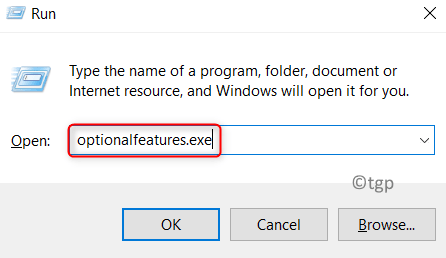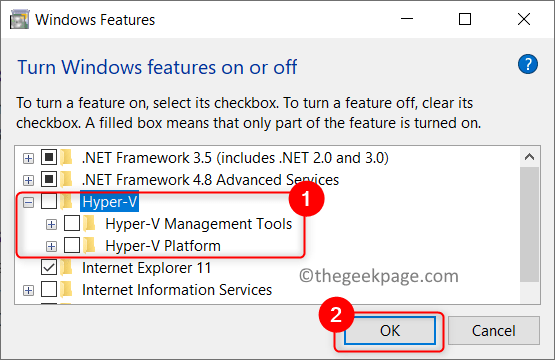A large number of users have reported seeing the error message “Raw-mode is unavailable courtesy of Hyper-V. (VERR_SUPDRV_NO_RAW_MODE_HYPER_V_ROOT)” while trying to boot a Virtual Machine on their Windows PC. Some have encountered this error even when the Hyper-V technology is turned off on their systems.
Read this article to find out the troubleshooting strategies adopted by users facing this issue.
Fix 1 – Turn Off Hyper-V
1. Using Windows and R key combination open Run dialog.
2. Type optionalfeatures.exe to open Windows Features.
3. In the Windows Features window, scroll down and look for Hyper-V in the list.
4. Uncheck the box associated with Hyper-V if it is checked.
5. Click on OK to confirm the changes.
6. Reboot the system and check if the error is fixed.
Fix 2 – Disable Hypervisor Check
Sometimes this error is seen even when Hyper-V is turned off. One situation that may be the cause is when the service HyperVisorLaunchType is set to Automatic. Disabling this service has helped users fix this error.
1. Open Run using Windows and R key combinations.
2. Type cmd and use the keys Shift, Ctrl, and Enter simultaneously to open Command Prompt with Admin privileges.
3. Click on Yes when prompted by UAC.
4. To check the Hypervisor status, type the command below and hit Enter.
bcdedit
5. In the displayed results, look for hypervisorlaunchtype and check the status.
6. If the status of this service is Off, then go to Fix 3 after skipping the steps below.
7. If the status of this service is set to Auto, use the command below to change the status of the service to Off.
bcdedit /set hypervisorlaunchtype off
8. Once the command executes, close the Command Prompt and restart your PC.
9. Open the VM and check if the issue is resolved after startup.
Fix 3 – Disable Device Guard in Group Policy Editor
1. Press Windows + R to open the Run dialog.
2. Type gpedit.msc to open Local Group Policy Editor. Click on Yes if you see a UAC prompt.
3. In the Local Group Policy Editor, go to the location mentioned below in the left pane.
Local Computer Policy --> Computer Configuration --> Administrative Templates
4. Select System folder within Administrative Templates.
5. Click on Device Guard within System.
6. On the right side, open the setting Turn on Virtualization Based Security by double-clicking on it.
7. In the setting window that appears next, select the option Disabled.
8. Click on Apply and then on OK to confirm the changes in settings.
9. Now open Run (Window + R), type cmd, and use the Ctrl, Shift, and Enter keys to open Command Prompt as administrator.
10. Enter the following set of commands one after the other to remove the EFI variables.
mountvol X: /s
copy %WINDIR%\System32\SecConfig.efi X:\EFI\Microsoft\Boot\SecConfig.efi /Y
bcdedit /create {0cb3b571-2f2e-4343-a879-d86a476d7215} /d "DebugTool" /application osloader
bcdedit /set {0cb3b571-2f2e-4343-a879-d86a476d7215} path "\EFI\Microsoft\Boot\SecConfig.efi"
bcdedit /set {bootmgr} bootsequence {0cb3b571-2f2e-4343-a879-d86a476d7215}
bcdedit /set {0cb3b571-2f2e-4343-a879-d86a476d7215} loadoptions DISABLE-LSA-ISO,DISABLE-VBS
bcdedit /set {0cb3b571-2f2e-4343-a879-d86a476d7215} device partition=X:
mountvol X: /d
copy %WINDIR%\System32\SecConfig.efi X:\EFI\Microsoft\Boot\SecConfig.efi /Y
bcdedit /create {0cb3b571-2f2e-4343-a879-d86a476d7215} /d "DebugTool" /application osloader
bcdedit /set {0cb3b571-2f2e-4343-a879-d86a476d7215} path "\EFI\Microsoft\Boot\SecConfig.efi"
bcdedit /set {bootmgr} bootsequence {0cb3b571-2f2e-4343-a879-d86a476d7215}
bcdedit /set {0cb3b571-2f2e-4343-a879-d86a476d7215} loadoptions DISABLE-LSA-ISO,DISABLE-VBS
bcdedit /set {0cb3b571-2f2e-4343-a879-d86a476d7215} device partition=X:
mountvol X: /d
Note: Here X is a placeholder for an unused drive. Enter a drive name based on your preference.
11. Restart your PC once you finish executing the command above. Check if the error has been fixed when you launch the VM.
Fix 4 – Turn Off Core Isolation Feature in Windows Defender
1. Hold Windows and R keys together to open Run.
2. Type ms-settings:windowsdefender to open Windows Security in Settings.
3. In Windows Security, select Device Security on the right pane.
4. Click on Core Isolation details below the Core Isolation option in Device Security.
5. Turn off the toggle next to the option Memory integrity in the Core Isolation features.
6. Reboot your PC and check if the issue is resolved.
If the toggle for the Memory Integrity option is disabled or there is an error while trying to turn it off, then follow the steps below.
1. Open Run (Windows + R) and type regedit to open Registry Editor.
2. Copy paste the location below in the navigation bar of the Registry Editor.
Computer\HKEY_LOCAL_MACHINE\SYSTEM\CurrentControlSet\Control\DeviceGuard\Scenarios\CredentialGuard
3. Once you have reached the above location, double-click on the Enabled key on the right-pane.
4. In the Edit window, let the base be Hexadecimal and set the Value Data to 0.
5. Close the Registry Editor and restart the system. Launch the Virtual Machine and check if the problem has been fixed.
Fix 5 – Enable Virtualization in BIOS or UEFI
1. For a BIOS-based computer, power on, and when you see the Startup screen press the Setup key (F2, F4, F6, F8 or Delete key).
2. If you have a UEFI PC, make use of the steps in this link to access the UEFI Firmware Settings.
3. Once you reach the settings, look for the option Virtualization technology related to your motherboard.
4. Make sure the Virtualization option is enabled.
Note: Generally, the location of this option differs among systems.
5. Now save these changes and reboot your PC in the normal way. Check if the hypervisor error still exists or not.
Thanks for reading.
We hope the fixes in this article must have helped you overcome the error associated with Hyper-V on your PC. Comment and let us know the fix that worked for you.


